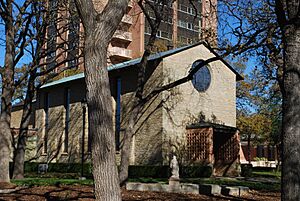Little Chapel in the Woods facts for kids
The Little Chapel-in-the-Woods is a beautiful chapel located on the campus of Texas Woman's University in Denton, Texas. It's a special place where people can go for quiet time, worship, or celebrations.
Contents
History of the Little Chapel
The Little Chapel-in-the-Woods was built a long time ago, during a period called the Great Depression. This was a time when many people in the United States did not have jobs. Even so, the chapel became known as one of Texas's most amazing buildings.
Building the Chapel
A famous architect named O'Neill Ford helped design the chapel. He worked with Arch B. Swank Jr. and Preston Geren Sr. Young people from a group called the National Youth Administration (NYA) helped build it. The NYA was a government program that gave jobs to young people during the Great Depression.
More than 300 students from the university's art programs also helped. They created all the beautiful artwork inside. This included the colorful stained glass windows, the lights, the wooden parts, doors, and even the floors.
A Special Dedication
The chapel became famous on November 1, 1939. On that day, Eleanor Roosevelt, who was the First Lady of the United States, officially opened the chapel. She was a big supporter of the NYA program. Mary Kathryn Jones, a student leader, introduced her to everyone who came to the event.
Since it was finished in 1939, the chapel has been a place for many different events. People use it for worship, quiet reflection, and happy celebrations.
Weddings at the Chapel
The Little Chapel-in-the-Woods is a very popular place for weddings. The first wedding there happened on September 25, 1939. Esther Webb, a graduate of the university, married John Hauseman.
Their names are written in the TWU Bride's Book. This book holds the names of every couple who has gotten married in the chapel since then. Today, more than 100 weddings take place in the chapel each year.
Awards and Recognition
The Little Chapel-in-the-Woods has received many awards over the years. These awards show how special and important the building is.
- From 2014 to 2017, the Little Chapel was voted the "Best Wedding Venue" in Denton County.
- In 2009, a magazine called Texas Monthly named it one of the 10 best buildings in all of Texas.
- In 1983, the Texas Society of Architects said it was one of the 20 buildings that showed "Texas' Proudest Architectural Achievements of All Time."
Beautiful Stained Glass Windows
The stained glass windows inside the Little Chapel are very special. They were designed to show "Women Ministering to the Human Needs." This means each window honors women who help others in different jobs. A student named Beatrice Paschall helped lead the design and creation of these windows.
The Motherhood Window
This window is above the altar, which is the main part of the chapel. It is the largest window and shows woman as a mother. The pictures in the glass show ideas like strength, kindness, loyalty, and love.
The Nursing Window
This window honors women who work as nurses. It celebrates all the women who helped create modern nursing. The main figure in the middle of the window shows what an ideal nurse looks like.
The Teaching Window
This window is dedicated to women who are teachers. It honors all the women who have used their knowledge to educate others. The main figures in this window represent Helen Keller and her teacher, Anne Sullivan.
The Music Window
This window celebrates women and their achievements in music. At the bottom of the window, it says "Gloria in Excelsis Deo," which means "Glory to God in the Highest."
The Dance Window
This window shows women who express beauty through movement and dance.
The Science Window
This window represents women who work in science fields. This includes chemistry, physics, and biology.
The Social Service Window
This window honors women who work tirelessly to help people in need. It shows their efforts to relieve suffering wherever they find it.
The Literature Window
This window represents women who are writers.
The Speech Window
This window represents women involved in the arts, especially those who use speech.
The Rose Window
This round window is above the entrance to the chapel. It shows the joy women find in the natural world around them.
The Signature Window
This is a small window in the entrance area. It shows the people who built, donated to, and decorated the chapel. They are shown in typical poses. Beatrice Paschall, a graduate student, supervised the design and creation of these windows. She worked under the guidance of local artist Dorothy LaSelle. Art students at Texas Woman's University crafted these windows between 1938 and 1941.


